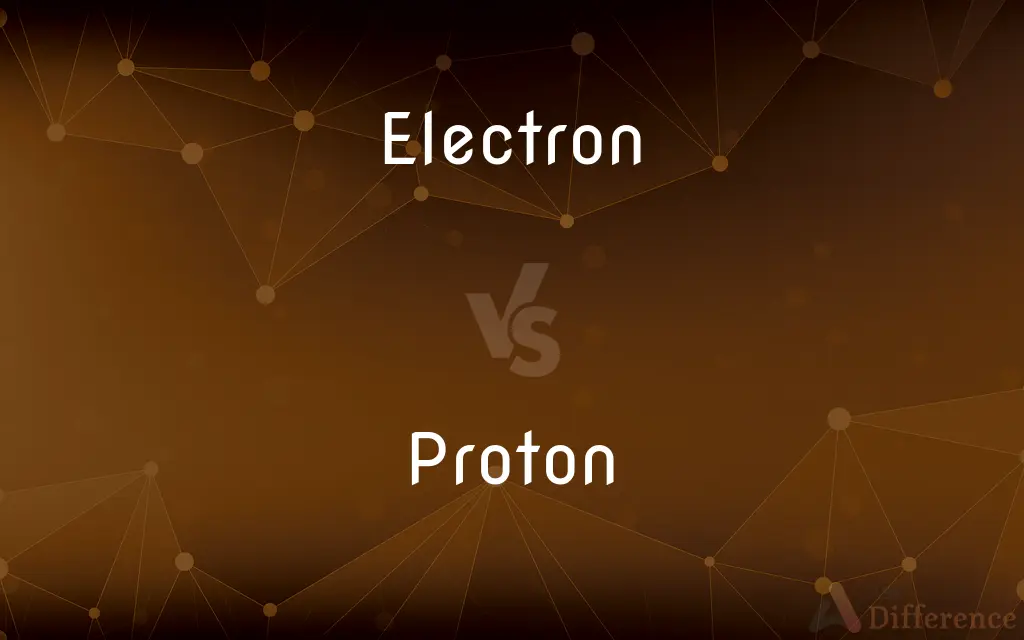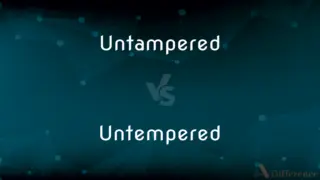Electron vs. Proton — What's the Difference?
By Urooj Arif & Fiza Rafique — Updated on March 25, 2024
Electrons are negatively charged particles orbiting an atom's nucleus, essential for chemical bonding, while protons are positively charged particles within the nucleus, determining the element's identity.

Difference Between Electron and Proton
Table of Contents
ADVERTISEMENT
Key Differences
Electrons are subatomic particles with a negative charge, playing a crucial role in chemical reactions and bonding due to their interaction with other atoms. They are found in the orbits around an atom's nucleus. Protons, on the other hand, are positively charged subatomic particles located within the nucleus of an atom. The number of protons in an atom's nucleus defines the chemical element and its properties.
The mass of an electron is significantly smaller than that of a proton. Specifically, an electron's mass is about 1/1836 that of a proton, making it much less influential in determining an atom's overall mass. Protons, with their greater mass, contribute significantly to the atomic mass of an element, alongside neutrons, which have a similar mass but no charge.
Electrons determine the atom's chemical behavior and its ability to form bonds with other atoms. This is because electrons can be shared between atoms in covalent bonds or transferred in ionic bonds, leading to compound formation. Protons, however, determine the atomic number of an element, which is fundamental to the element's identity on the periodic table and its chemical properties.
The interaction between electrons and protons is fundamental to the structure of atoms. Electrons are attracted to protons by the electromagnetic force, helping to keep electrons in orbit around the nucleus. This balance of positive and negative charges within atoms is crucial for the stability of matter.
Changes in the number of electrons in an atom can lead to the formation of ions. When an atom gains or loses electrons, it becomes, respectively, a negatively or positively charged ion. In contrast, changes in the number of protons would result in the transformation of one element into another, a process that typically occurs in nuclear reactions, not chemical reactions.
ADVERTISEMENT
Comparison Chart
Charge
Negative
Positive
Location
Orbits around the nucleus
Within the nucleus
Mass
~1/1836 of a proton
~1 atomic mass unit (amu)
Role in Chemistry
Determines chemical properties and bonding
Determines the atomic number and element identity
Impact on Atomic Mass
Minimal
Significant contribution
Behavior in Reactions
Can be transferred or shared in bonds
Remains unchanged in chemical reactions
Compare with Definitions
Electron
Electrons carry a negative charge.
An electron's negative charge balances the positive charge of protons in an atom.
Proton
Significantly greater than that of electrons.
Protons contribute the most to an atom's mass, along with neutrons.
Electron
Found in the orbits around an atom's nucleus.
Electrons determine an atom's reactivity by their arrangement in orbitals.
Proton
Resides within the nucleus of an atom.
The number of protons in the nucleus determines an element's identity.
Electron
Extremely small compared to protons.
The mass of an electron is so small it's often considered negligible in atomic mass calculations.
Proton
Number remains constant in chemical reactions.
Changing the number of protons would change the element itself.
Electron
Essential for chemical bonding and reactions.
Electrons are shared in covalent bonds, forming molecules.
Proton
Protons carry a positive charge.
The positive charge of a proton defines the atomic nucleus's charge.
Electron
Loss or gain leads to ionization.
Gaining an electron forms a negatively charged ion.
Proton
Defines the chemical element.
The atomic number, equal to the number of protons, identifies the element.
Electron
The electron is a subatomic particle, symbol e− or β−, whose electric charge is negative one elementary charge. Electrons belong to the first generation of the lepton particle family, and are generally thought to be elementary particles because they have no known components or substructure.
Proton
A proton is a subatomic particle, symbol p or p+, with a positive electric charge of +1e elementary charge and a mass slightly less than that of a neutron. Protons and neutrons, each with masses of approximately one atomic mass unit, are jointly referred to as "nucleons" (particles present in atomic nuclei).
Electron
A stable elementary particle in the lepton class having a negative electric charge of 1 elementary unit (about 1.602 × 10-19 coulombs) and a mass of about 9.11 × 10-28 grams. Electrons are found in shells orbiting the nuclei of atoms and can also move freely through space as cathode rays in a cathode-ray tube or as beta particles emitted by radioactive nuclei, or flow in a current through a conducting material impelled by an electric potential difference.
Proton
The stable, positively charged nucleon, having a mass 1,836 times that of an electron and being a baryon composed of two up quarks and one down quark. The proton is a basic component of all atomic nuclei and the nucleus of the protium isotope of hydrogen.
Electron
(particle) The subatomic particle having a negative charge and orbiting the nucleus; the flow of electrons in a conductor constitutes electricity.
Proton
(particle) A positively charged subatomic particle forming part of the nucleus of an atom and determining the atomic number of an element, composed of two up quarks and a down quark.
Electron
Alloys of magnesium and other metals, like aluminum or zinc, that were manufactured by the German company Chemische Fabrik Griesheim-Elektron.
Proton
The atomic nucleus of protium hydrogen-1}}
Electron
Amber; also, the alloy of gold and silver, called electrum.
Proton
Synonym of primordium
Electron
One of the fundamental subatomic particles, having a negative charge and about one thousandth the mass of a hydrogen atom. The electron carries (or is) a natural unit of negative electricity, equal to 3.4 x 10-10 electrostatic units, and is classed by physicists as a lepton. Its mass is practically constant at the lesser speeds, but increases due to relativistic effects as the velocity approaches that of light. Electrons are all of one kind, so far as is known. Thus far, no structure has been detected within an electron, and it is probably one of the ultimate composite constituents of all matter. An atom or group of atoms from which an electron has been detached has a positive charge and is called a cation. Electrons are projected from the cathode of vacuum tubes (including television picture tubes) as cathode rays and from radioactive substances as the beta rays. Previously also referred to as corpuscle, an obsolete term. The motion of electrons through metallic conductors is observed as an electric current. A particle identical to the electron in mass and most other respects, but having a positive instead of a negative charge, is called a positron, or antielectron
Proton
A stable particle with positive charge equal to the negative charge of an electron
Electron
An elementary particle with negative charge
Common Curiosities
How do electrons influence chemical reactions?
Electrons participate directly in chemical reactions through the formation of bonds by either sharing electrons between atoms or transferring them from one atom to another.
What happens if an atom loses or gains electrons?
It becomes an ion; loss of electrons results in a positive ion (cation), while gain of electrons results in a negative ion (anion).
Can an element have different numbers of electrons and protons?
Yes, when this occurs, the atom is no longer neutral and is referred to as an ion.
What role do neutrons play compared to protons and electrons?
Neutrons, located in the nucleus alongside protons, contribute to an atom's mass but not its charge. They play a critical role in the stability of the nucleus.
What determines the chemical properties of an element?
The number and arrangement of electrons in an element determine its chemical properties, as these affect how it interacts and bonds with other elements.
What is the significance of electron orbitals?
Electron orbitals define the regions around an atom's nucleus where electrons are likely to be found, influencing an atom's chemical behavior and bonding capabilities.
What determines the charge of an atom?
The balance between the number of protons (positive charge) and electrons (negative charge) determines an atom's overall charge.
Why is the electron's mass considered negligible?
Because its mass is so much smaller than that of protons or neutrons, it has minimal impact on the total mass of an atom.
Can the number of protons in an atom change?
In chemical reactions, no, but in nuclear reactions, such as nuclear decay or fusion, the number of protons can change, transforming one element into another.
How does the number of protons affect an element's properties?
The number of protons determines the atomic number, which defines the element and its position on the periodic table, influencing its chemical properties.
Why can't chemical reactions change the number of protons?
Chemical reactions involve the rearrangement of electrons between atoms; changing the number of protons would involve altering the nucleus, which requires nuclear reactions.
What is ionization energy?
Ionization energy is the energy required to remove an electron from an atom or ion, reflecting the strength of an atom's hold on its electrons.
How are electrons and protons similar?
Both are fundamental subatomic particles essential to the structure and function of atoms, with opposite charges that attract each other, maintaining atomic stability.
How does the electron's role in bonding contribute to molecular structures?
Electrons form bonds between atoms by either sharing in covalent bonds or transferring in ionic bonds, determining the molecular structure of compounds.
What happens during a nuclear reaction in terms of protons and electrons?
In nuclear reactions, the number of protons can change, altering the element itself; electrons may be affected indirectly through changes in charge balance but are not the focus of nuclear transformations.
Share Your Discovery

Previous Comparison
Untampered vs. Untempered
Next Comparison
Goal vs. ObjectiveAuthor Spotlight
Written by
Urooj ArifUrooj is a skilled content writer at Ask Difference, known for her exceptional ability to simplify complex topics into engaging and informative content. With a passion for research and a flair for clear, concise writing, she consistently delivers articles that resonate with our diverse audience.
Co-written by
Fiza RafiqueFiza Rafique is a skilled content writer at AskDifference.com, where she meticulously refines and enhances written pieces. Drawing from her vast editorial expertise, Fiza ensures clarity, accuracy, and precision in every article. Passionate about language, she continually seeks to elevate the quality of content for readers worldwide.
















































